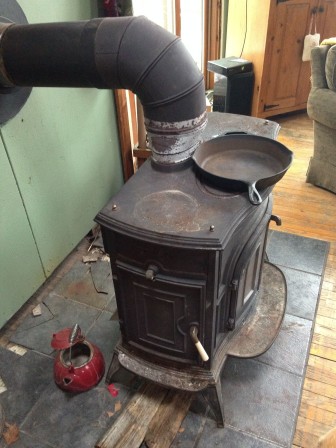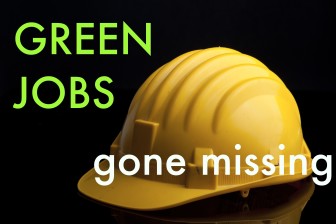
Victorgrigas
In rural areas, households using wood-burning stoves were sometimes turned down because, even if the environmental and health impact of a retrofit made it a no-brainer, the financial savings were fairly small.
It wasn’t solar panels, hydroelectric power or wind-generated electricity that was supposed to power New York State’s attempt to create a greener New York under the 2009 Green Jobs/Green New York Act—the program that aimed to spur massive numbers of property owners to retrofit their homes and buildings to reduce energy waste and create jobs.
The driving force for the program, at least when it came to reaching lower-income households, was on-bill financing—OBR for short.
With OBR financing, utility companies offer customers the option of adding the principal and interest amounts of the loan to their utility bill payments over the term of the loan. Applicants for on-bill recovery financing offered through the NYSERDA program can choose a loan term of five, 10, or 15 years. The vast majority of the borrowers interviewed for this story mentioned that they opted for the 15-year loan term.
The belief is that the cost savings of the energy efficiency improvements will offset the additional expense of the loan and that the retrofits will be “bill-neutral”. In other words, the total amount of the utility bill will remain more or less the same until the loan is paid in full, at which point borrowers will reap the cost savings benefits of their energy–efficiency home improvements — although the OBR Notice to Borrower explains that taking on the loan does not guarantee lower energy costs “over time.”
Using utility bills as a financing mechanism would, GJGNY’s designers hoped, provide a lower-income population burdened by relatively poor credit scores and relatively high debt-to-income ratios with a chance to get retrofits.
This did not happen, largely because the approach GJGNY took to implementing on-bill recovery undermined the program’s potential. Utility companies, lenders and ratings companies all made demands and decisions that made the approach a poor fit for households of limited means.
Utility companies balk
According to NYSERDA and a spokesperson from Con Edison, utility companies expressed concerns that adding loan repayments to their bills would increase monthly non-payments from their customers. That made utilities nervous in part because enforcing green-energy loans is difficult. Energy efficient loans are what’s known as “non-recourse” loans, in that no repo man is going into someone’s home and start ripping out their newly installed heating ducts. So, the only way utility companies could compel payment would be to shut off the lights.
The utilities didn’t want to have to act like loan sharks. So they insisted that customers’ payments be separated: Every month, the fee for utilities would get paid first, and whatever remained of a customer’s payment would go towards paying off the retrofit loan.
On one hand, this move failed to save the utilities from playing the bad guy: Termination of service (turning the lights out) is still the recourse for skipping an on-bill retrofit repayment, according to NYSERDA. However, this is a rare option. Lights can only be turned off during certain seasons and utility companies do a lot to make sure they avoid a lights out situation.
On the other hand, by separating the utility and loan payments, it meant that the ratings companies (who evaluate the riskiness of the bonds that underwrite NYSERDA’s programs) could not value these loans as utility bill payments, which all customers usually pay regularly. Instead, on-bill financing had to be considered a regular consumer-style loan, only available to homeowners with a credit score better than 640 and an “acceptable” debt-to-income ratio—undermining the whole point of on-bill lending.
Another problem, according to NYSERDA, is there was not enough data on on-bill financing for the ratings companies to verify that there would be a lower default rate on on-bill loans. This even though a comprehensive survey of OBF (“on-bill financing”) programs, dating back to the pilot program in Wisconsin in 1993, show significantly lower default rates among programs in 23 states.
Emmaia Gelman, who played a key role in the negotiations over the Green Jobs program while at the Center for Working Families, said that one reason that creditworthiness became the measure of the loans’ sturdiness was that socially conscious investors would not sign on.
“The problem was there were no lenders interested in providing capital with a low rate of return,” she said. “Lenders didn’t care that OBF shows a good repayment rate.”
An idea, undermined
The Green Jobs/Green New York underwriting criteria for both types of loans—traditional Smart Energy loans and loans involving on-bill financing — are divided into two tiers.
Tier 1 represents the more traditional borrower, who has a 640 credit score or higher, up to 50 percent debt-to-income ratio, no outstanding debt totaling more than $2,500 and is clear of bankruptcy, foreclosure or repossession within the last seven years.
Tier 2, on the other hand, offers expanded qualifications for homeowners with poorer credit. Applicants with credit scores as low as 540 can qualify under this tier as long as they’re current on all mortgage payments, free of outstanding debt totaling more than $2,500 and clear of bankruptcy, foreclosure or repossession within in the last two years. This is the household for which On-Bill Financing was designed.
The problem, though, lies in the debt-to-income criteria. Under Tier 2, applicants with a 680 or higher credit score can have a debt-to-income ratio of up to 80 percent. Homeowners with a credit score below 599 — often an indicator of more debt and less income — are only allowed up to 70 percent debt-to-income.
So while On-Bill Recovery’s credit score requirement is flexible enough to allow people with poor credit to apply, the underwriting criteria didn’t take into account the reality of living with limited income in an expensive city.
“In a housing market like New York City, a lot of [homeowners] have very high debt to income ratios because they’re paying off their mortgages,” says Jessica Bartolini, energy efficiency program supervisor for Chhaya CDC, which works with the South Asian population in Queens.
Chris Neidl, director of Here Comes Solar, has more than a decade’s worth of experience working with solar energy initiatives, both domestically and internationally. Neidl has no direct experience with the Green Jobs-Green NY program but believes, in principle at least, that on-bill recovery financing is an attractive option. The problem, says Neidl, is that perhaps OBR’s design made it poorly suited for those it was intended to help.
“The credit score requirements were actually quite high. I don’t know if they matched the intended population very well,” says Neidl. “It was certainly very good in terms of the term and the interest rate but how many low-income people are really eligible for that given the credit score requirements?” asks Neidl.
Upper income borrowers — which NYSERDA identifies as “market rate” or making more than $100,000 — made up more than half of the total GJGNY residential loan value between 2010 and 2015. By contrast, low-income (those making less than $69,050 for a family of four in New York City) and moderate-income (a family of four making less than $104,000) homeowners only made up 19 percent of nearly $75 million in energy efficiency loan funds, according to a report by NYSERDA.
What price, a cleaner home?
What makes retrofit programs complicated is there is virtually no way to track the savings brought about by an energy efficiency project. Savings on an energy bill are largely based on the activity of those using the outlets. So, the savings are always an estimate and NYSERDA says that they have no way of monitoring the actual savings in individual households that have taken out on-bill loans. If a consumer starts working from home, or a new family member moves in, the agency loses the ability to track the savings.
Sources say GJGNY was set up to falter when weighing the value of a particular retrofit. Loan amounts were capped at $25,000, and Neidl says he knows of individuals who contemplated the GJGNY financing but ultimately went with other options because they found the loan cap to be too limiting.
Meanwhile, NYSERDA also disqualified some low- and moderate-income homes because they were in such disrepair — a common problem among the lowest-income households — that the amount of projected savings would not justify the cost of the retrofitting, advocates say. In rural areas, households using wood-burning stoves were sometimes turned down because, even if the environmental and health impact of a retrofit made it a no-brainer, the financial savings were fairly small.
“The state had really good intentions, but the way that [On-Bill Recovery] was set up made it more complicated,” Oliver says.
Launched during a recession triggered in part by financial tricks that piled debt on those who couldn’t pay, GJGNY can at least be credited with not having layered low-income households in New York with a new set of IOUs. But it appears to have demonstrated that a retrofit program built on borrowing by people of limited means is doomed to fail.
“I’m not sure that I would say that On-Bill is intended for low or moderate income families,” said James Barrett, Chief Economist at the American Council for an Energy Efficient Economy. “If you do have a home and have bad credit, maybe adding a loan to your debt stack may not be a good idea even though it should save you money.”
Without capital from the state, some say, low-income New Yorkers will likely be left out of the retrofit movement. Tayyab Buksh, construction services director for Neighborhood Housing Services of Jamaica, Inc., puts it simply: “[We don’t] encourage homeowners to take out loans because it will make them incur more debt that they can’t afford.”
This series was produced by members of the fall 2015 urban investigative reporting course at the CUNY Graduate School of Journalism.










2 thoughts on “Flaws Plagued Pioneering Plan to Upgrade Homes of the Poor”
The obf repayments around the country have been consistent regardless of income level. The utilities in NY need to stop making excuses. Maybe regulators need to step in
No surprise here. Throughout these programs are based not on the needs and the economics of the home owner but on the politics of the moment. In other words, if someone determines that XYZ technology can save energy, they bamboozle homeowners into buying XYZ technology, without any meaningful assessment of the economics of the property, and in the vast majority of cases these programs serve the vendors better than the homeowners.